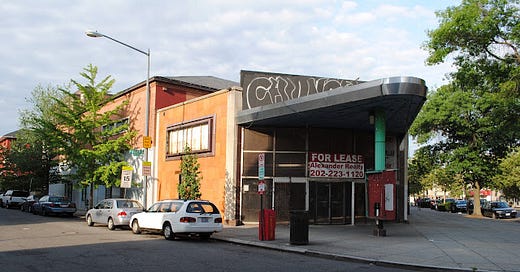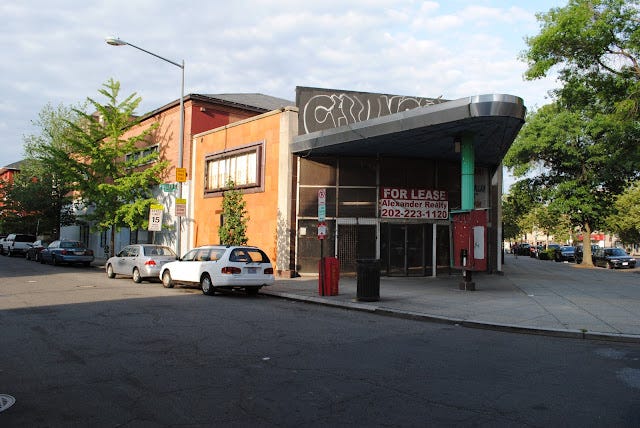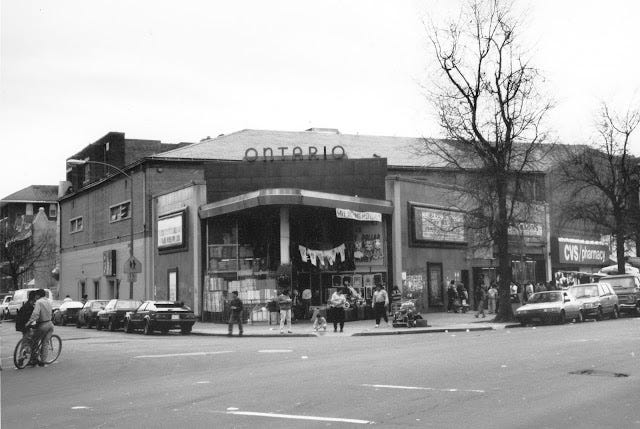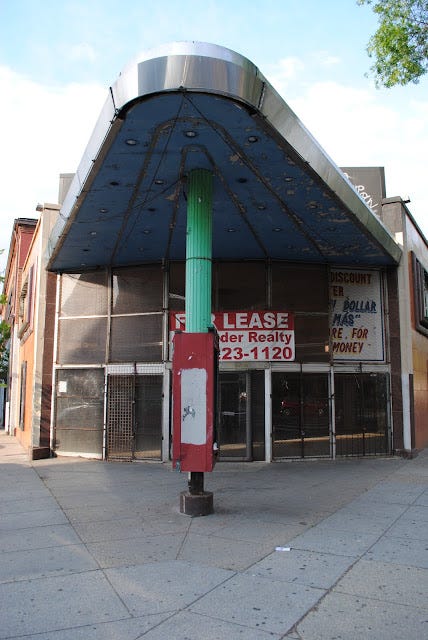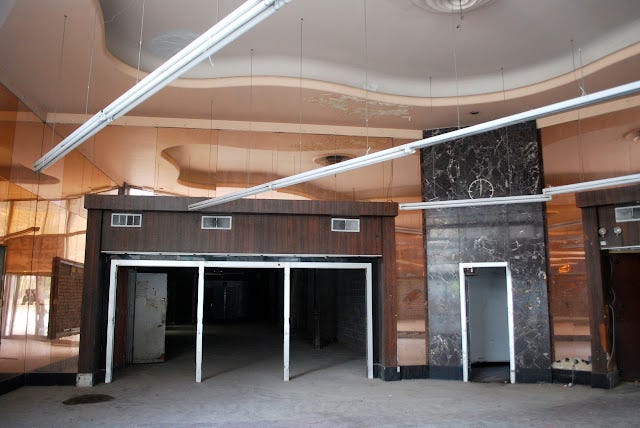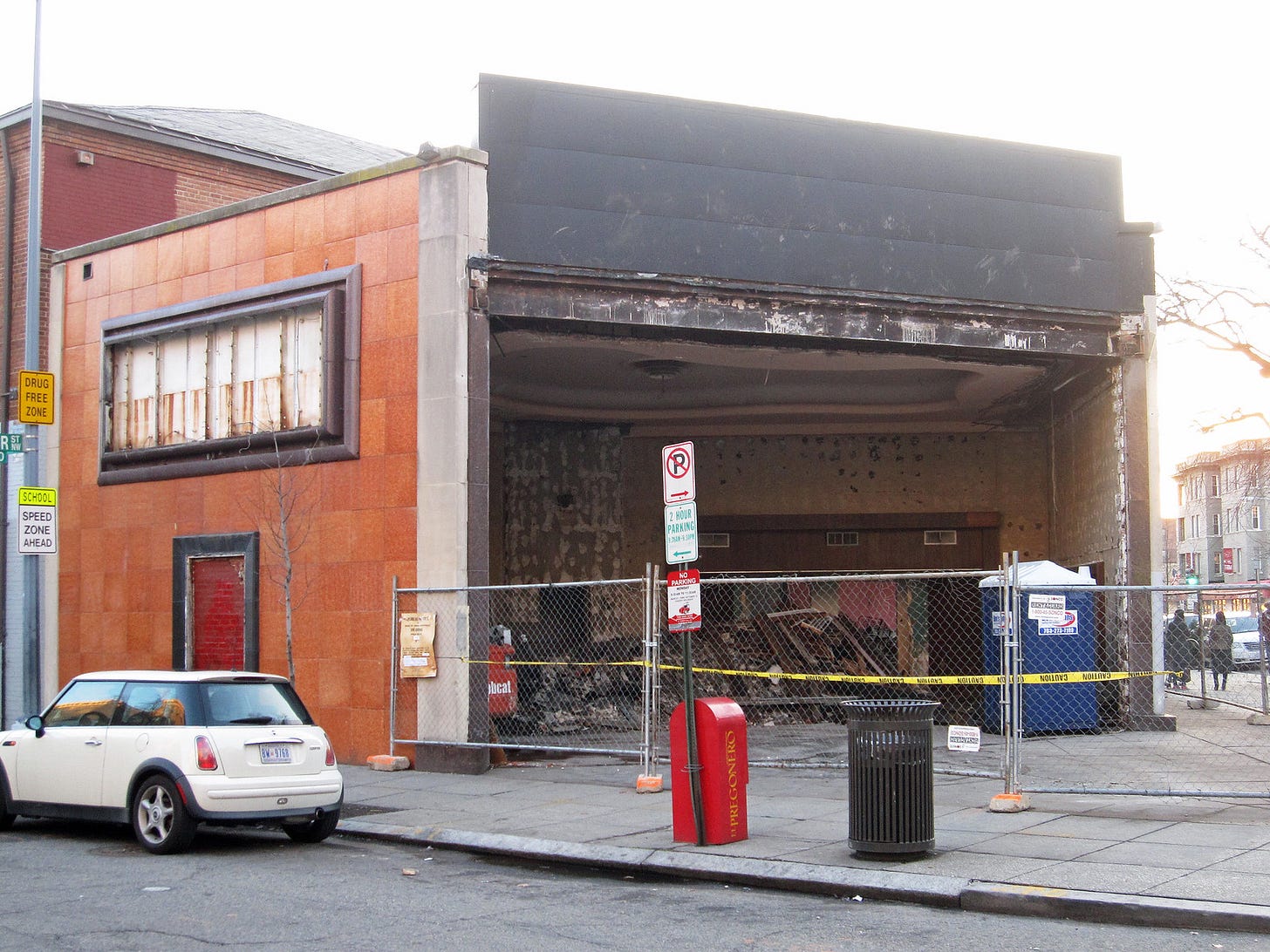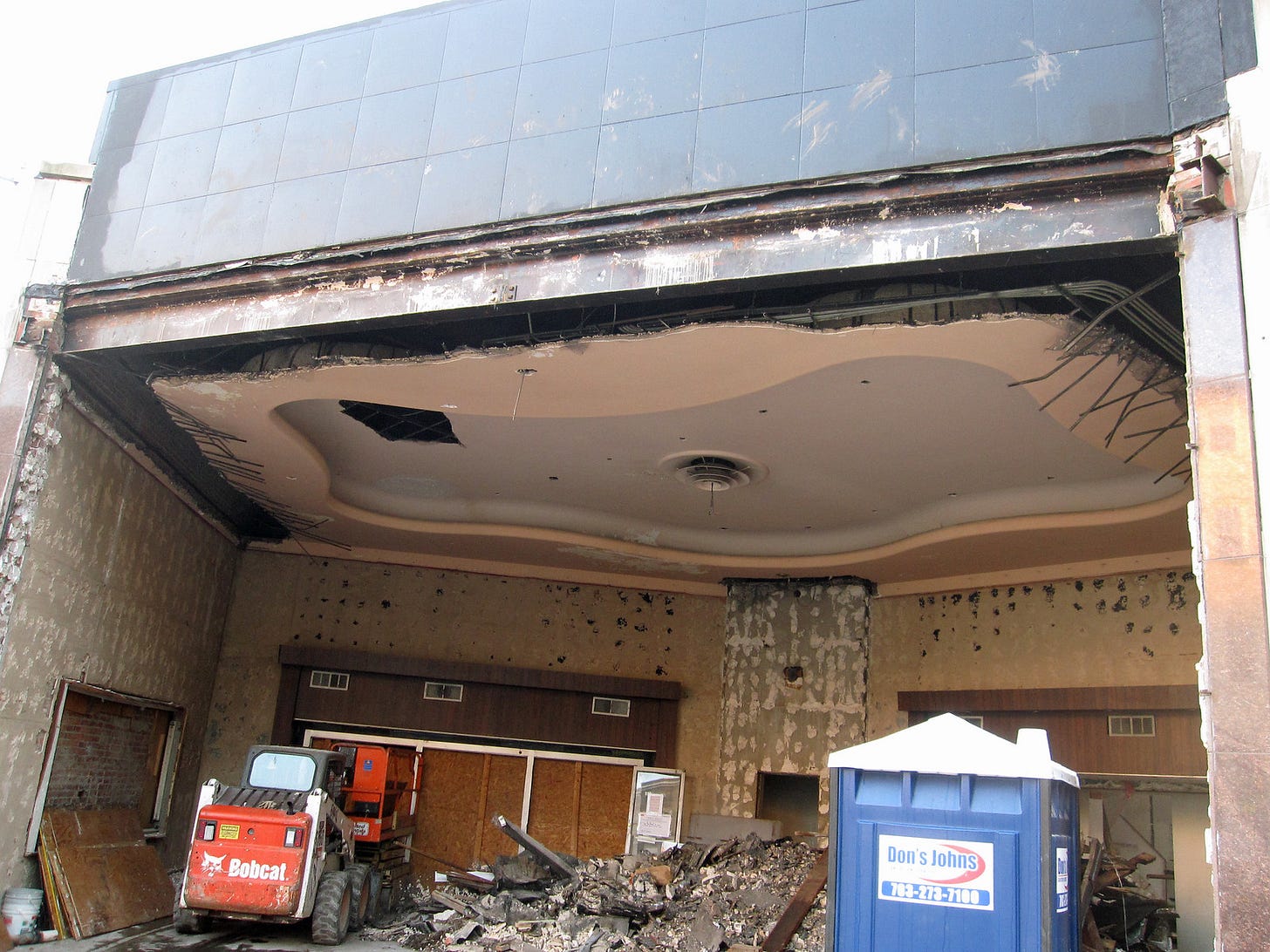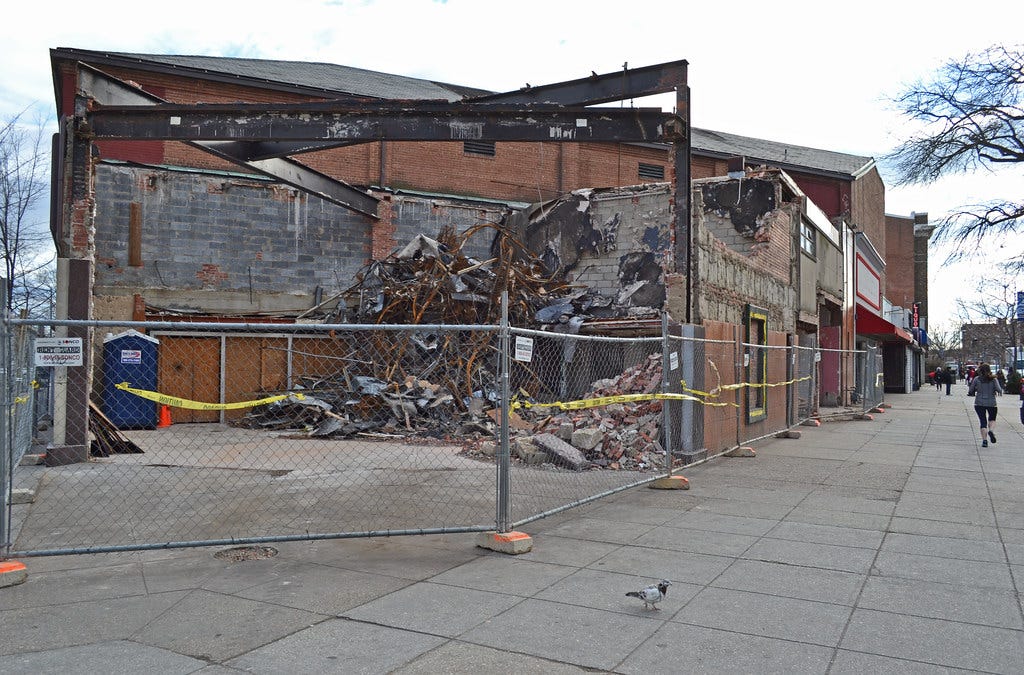The Ontario Theatre's Many Past Lives
Located at 1700 Columbia Road, NW, in Adams Morgan, the former Ontario Theatre doesn’t look like much these days. It’s been a couple decades since it was a functioning theater. Most recently, there was a discount store in its old lobby, offering clothing, luggage, toys, you name it. The store went out of business in 2008. Just a few years earlier, the theater’s sleek original stainless-steel letters, spelling O-N-T-A-R-I-O across the roofline, were taken down, making it all the harder to recognize the building for what it used to be—one of the city’s classiest movie theaters.
The empty theater building in 2011. Photo by the author.
The theater’s history spans elegant premieres of acclaimed motion pictures, concerts by notable bands of the Rock ’n Roll era, and groundbreaking screenings of Spanish-language films for a community that previously had little access to such entertainment. While the theater “reinvented” itself several times over, often struggling to find its identity, it managed in the process to serve as a vital and exceptional community resource, an entertainment venue that had few rivals in this part of town.
Completed in 1951 for the K-B theater chain, the Ontario was designed by accomplished theater architect John J. Zink (1886-1952) and his associate, Frederick L.W. Moehle (1903-1959). Zink was one of the most important theater architects in Washington, a man who developed a deep appreciation for the unique requirements of these highly specialized buildings. A native of Baltimore, Zink studied in New York with Thomas W. Lamb (1871–1942), one of the foremost theater and cinema architects of the 20th century and the designer-to-be of the nearby Tivoli Theater (1924). His first DC project was the Rialto on 9th Street downtown. Completed in 1918, it was one of the largest movie palaces of its day and had an extraordinarily ornate interior. Zink would go on to design some 14 movie theaters in the District, ranging from the neoclassical Takoma Theatre (1923) to the ultra-modern Ontario. Zink is probably best known for his exquisite art deco designs, including the much-loved Uptown (1936) as well as the Newton (1937) and the Apex (1940), a wonderful neighborhood theater in Spring Valley that was destroyed in 1977.
World War II marked a turning point in theater design as in almost everything else. Perhaps the exuberance of art deco started to seem naïve; in any event, it was out-of-date. There had also been a hiatus in theater construction due to wartime constraints that persisted through the 1940s. When it came time at the end of the decade to design the Ontario, Zink and his associate Moehle came up with an entirely new mid-century modern look that captured the spirit of the age—the age of automation—with its bold geometric shapes and bright colors. Most striking is the prominent stainless-steel-rimmed marquee that juts out towards the sharply-angled intersection of 17th Street and Columbia Road. Its clean, rounded lines reflect the new aesthetic, as does the exposed support pole with glassed frames for movie posters. Then there is that glazed orange terracotta tile work; whether you love it or hate it, its boldness is undeniable. The Ontario’s sleek, futuristic glamor is unparalleled in other surviving Washington, D.C. theaters.
The Ontario in 1994. Photo by Scott Seymour via Flickr. Used with permission.
At the time of the Ontario’s construction, this dense residential section of the city was thought to be overdue for an additional movie theater. There were already two large movie houses in the area—the Tivoli at 14th Street and Park Road and the Ambassador (1917/23, now demolished) at 18th Street and Columbia Road. As early as 1945, the Roth’s Theater chain had planned a theater a block away at Columbia Road and Mozart Place, NW, but it was never built. It was the K-B chain, at one point the largest in the D.C. area, that constructed the Ontario. The company was founded by Fred S. Kogod (1900-1956) and Max Burka (1891-1966), two immigrants from Eastern Europe who had gotten their start in the grocery business in the early 1920s. They stumbled into movie theaters in 1926 after purchasing a building on H Street, NE, that had a theater (the Princess) on the first floor. When the theater’s manager quit, they found themselves running it on their own. It turned out to be quite successful. They went on to build the beautiful Apex in 1938 and within a few years were planning a new venue for the site on Columbia Road but had to wait for wartime restrictions and a pre-existing lease to run out. The Ontario was one of just two theaters constructed in the District of Columbia during the 1950s.
When finally completed in 1951, the Ontario was stylish and up-to-date, with all the latest amenities. The auditorium featured Bodyform Pushback seats built by the American Seating Company, allowing patrons to “simply slide back” to allow others to pass rather than having to get up from their seats. Generous spacing was provided between the rows, and the seating arrangement was staggered to ensure maximum visibility in all parts of the house. The auditorium also had two enclosed balcony rooms, one a nursery for children and the other a private party room seating 47 people. The lobby was designed by prominent Philadelphia decorator David E. Brodsky (1903-1995) in a stylish gold-gray scheme intended to convey a distinctly modernistic vision of the high life. Recessed lighting hid behind a wonderfully fluid amoeba-like design on the ceiling, while large marble piers accented the theme of luxury. With 1,400 seats, the Ontario was an exceptionally large neighborhood theater and one of the largest overall in the city. It was said to have cost a pricey $500,000 to build.
The Ontario's arcade in 2011. Photo by the author.
The theater’s first feature when it opened on November 1, 1951, was a comedy called Rhubarb, starring Ray Milland and Jan Sterling. According to Robert K. Headley’s Motion Picture Exhibition in Washington, D.C., the Ontario was the first neighborhood theater in Washington to break the monopoly of downtown theaters on showing first-fun features. Theater critic Richard L. Coe marveled in January 1952 that the Ontario was splurging on first-run films, effectively outbidding the “downtown palazzos.”
The Ontario reflected the social tensions of its times as well as the cosmopolitan tastes of upper Northwest Washington, D.C. residents. It hosted the Washington premiere of Death of a Salesman in March 1952, and members of the local American Legion, reflecting the Cold War hysteria of the day, picketed outside the theater, calling the film “un-American” because of Arthur Miller’s left-leaning sympathies. Surprisingly, only eight years later, the theater showed a Soviet production of Eugene Onegin, based on the Tchaikovsky opera and Pushkin novel, which seemed to cause no stir at all and was praised by The Washington Post’s theater critic, Paul Hume. The Lenfilm production, filmed in “Sovcolor,” was a beautiful production, he wrote in 1960.
Several premieres at the Ontario were significant cultural events. More than 200 diplomats, congressmen, Supreme Court justices, and other high government officials were invited to the February 1963 premiere of Lawrence of Arabia, for example, and many prominent Washington hostesses hosted commemorative dinners before the gala showing. As the VIPs disembarked from their limousines in front of the streamlined arcade of the Ontario, commentator Hazel Markel announced each arrival to a wide radio audience “with as much aplomb and confidence as the best receiving line announcer at any large Washington party,” the Post observed.
The theater’s most successful and longest-running production was The Sound of Music, which opened at the Ontario in 1965 and ran for two years. In March 1966, a lavish celebration was held to mark the first year of the film’s run, with cast members and Swiss folk music groups in attendance. However, the success of The Sound of Music was soon followed by major cultural shifts in the Washington landscape.
The riots following the assassination of Dr. Martin Luther King, Jr., in April 1968, included looting and burning just a few blocks east of the Ontario, and the theater’s traditional patrons quickly grew uneasy about the neighborhood. The hit movie Funny Girl did poorly when it opened at the Ontario in late 1968 but brought in many more customers when the K-B chain moved it across the park to its Wisconsin Avenue theater in early 1969.
The lobby of the Ontario in 2009. Photo by Scott Seymour via Flickr. Used with permission.
In August 1969, responding to the significant demographic changes affecting the Adams-Morgan neighborhood, the theater converted to showing Spanish-language films, beginning with a double bill of El Yaqui and Así Es Mi Mexico, all without English subtitles. Marvin Goldman, co-owner of the K-B chain at the time, explained to The Evening Star why he had undertaken this “audacious” experiment: “In general, in the past and still today…pictures in the Spanish language have been shown, in this country, in inferior theaters—what we call junk houses—in New York City, Los Angeles, and especially in the border states—Arizona, New Mexico, Texas. We decided on a new wrinkle—to invite Washington’s Spanish-speaking community to see pictures in their language in the setting of a beautiful house with one of the most luxurious decors in the nation. The response has been gratifying. Latin audiences flock to the Ontario…” According to the Star, many of the theater’s new patrons were Cuban exiles.
Films starring the Mexican comedian Cantinflas were the biggest draw, and crowds were always largest on Sunday afternoons, unlike theaters showing “traditional” fare, which did their most business on Friday and Saturday evenings. “We come on Sunday because it is one of the few days we have free from work,” a Bolivian immigrant told Post reporter Bill Bancroft in November 1971. “The audience appeared to be more like a family gathering at a church social than an American movie audience,” Bancroft observed. “Father and mothers trooped in with their small children, including infants. Grandparents were included in some groups. Many talked while the movie was in progress.”
After almost a decade of success, the revived Teatro Ontario Internacional was threatened in 1977, after the K-B chain sold it to Paul S. Tauber and Herbert White for $400,000, slightly less than it had cost to build 26 years earlier. Tauber and White decided they would discontinue the Spanish-language format and instead offer a mix of repertory and first-run features to cater to the affluent whites who seemed to be returning in significant numbers to the culturally-diverse Adams-Morgan neighborhood. However, Tauber and White misread the extent to which the Adams-Morgan community had changed. Tauber was quoted in the Post as saying that “There is no Spanish Community here anymore,” which naturally angered the Latino community and led to a temporary boycott of the theater. One evening a group of some 200 protesters blocked the entrance to the theater. “Who says we don’t exist?” read the statement they issued. In response, Tauber quickly backed off of the new policy, blaming the media for misquoting him. Carlos Rosario, a community leader who was instrumental in the formation of the D.C. Office of Latino Affairs, stepped in and arranged to rent out the Ontario on Sundays so it could continue to show Spanish language films once a week.
The Columbia Road facade, looking pretty rundown. Photo by the author.
The Ontario was sold again in 1979, when its “outrageous” years began, a time when it would run anything that would bring in patrons. Carlos Rosario bought the theater in 1980 and struck an arrangement with local disc jockey Seth Hurwitz to do weekday programming while Rosario focused on the profitable Spanish language films on the weekend. In March 1979, the Ontario showed the Bruce Lee film Enter The Dragon, which was a big hit. Horror films like the sadistic I Spit On Your Grave became staples at the theater, although the audience could be fickle. An exasperated Hurwitz told Post reporter Michael Kernan in 1981, “I tried 'Elephant Man,' and that didn't go. I tried 'Straw Dogs,' which has plenty of violence, but it didn't go.... But they loved 'Gloria,' which is a classy movie but violent.” Kernan wrapped up his article about the Ontario’s quirky repertoire by observing: “The other night they had a ridiculous picture called 'Dracula's Dog.' A guy came up to the box office and said, 'I dint know Dracula had no dawg.' But he paid his $3 and went in anyway.”
In these years, under Hurwitz’ guidance, the Ontario also became known as Washington’s premiere venue for live New Wave, punk, and Rock ’n Roll shows. Among the shows that appeared were nationally–recognized artists such as Blondie, U2, the Police, R.E.M., and the Clash. The concerts could get rowdy sometimes, as noted by nearby resident Leslie Kuter in a letter to the Post in October 1980: “As I lay in bed after midnight [on a recent night], some crazed rocker would periodically open the back doors of the Ontario Theatre and the music of Todd Rundgren and Ian Hunter (the rock stars) would fill the back alley and my bedroom.... Last year at about this time, we had riots. Some of my neighbors were robbed. Fortunately, on the night of Oct. 9, damage didn't go beyond shouting, roaring cars and drunk stares from real toughies made brave by raunchy rock...” Whatever its merits, the rock era would only last a few more years at the Ontario. Seth Hurwitz would move on by the mid 1980s to acquire and manage the acclaimed 9:30 Club on F Street downtown.
In 1983, the Circle Theaters chain purchased the Ontario. Despite the proven popularity of the Spanish-language fare, the new owners opted to once again try “art films and movies for a sophisticated market.” In 1985, extensive interior renovations were undertaken to allow the theater to once again show first-run features, which hadn’t been shown there since Funny Girl in 1969. While the renovations and new programming had some initial success, the theater was permanently closed just two years later, in May 1987. The owners claimed that the large, single-screen theater was not economically feasible as a neighborhood venue.
The facade was removed as demolition began in February 2013 (photo by the author).
Subsequently, the building was used for a variety of retail purposes. A People’s Drug Store (later CVS) filled the former auditorium space beginning in the late 1980s. A Domino’s Pizza outlet operated from space on 17th Street. Then the discount store moved into the former lobby space. All are gone now, as the building’s owners reportedly contemplate replacing it with a new condominium development. At one point an historic landmark nomination was filed to protect the theater, but the nomination was withdrawn after the owners agreed to preserve several symbolic architectural elements from the old building, including its iconic marquee, to be incorporated into the planned new building. Demolition of the Ontario began in February 2013.
David Brodsky's stylish amoeba-like ceiling was still visible as demolition began in February (photo by the author).
Demolition continued in March 2013 (photo by the author).
Much of the research for this article was done originally for the Ontario’s historic landmark nomination. Robert K. Headley and D. Peter Sefton provided invaluable assistance. Headley is the author of the authoritative reference book on DC movie theaters, Motion Picture Exhibition in Washington, D.C. (1999). Additional information came from an assortment of newspaper and magazine articles as well as Adam Rubin's "Our Own Outrageous Ontario: A History of Adams Morgan's Ontario Theatre."

